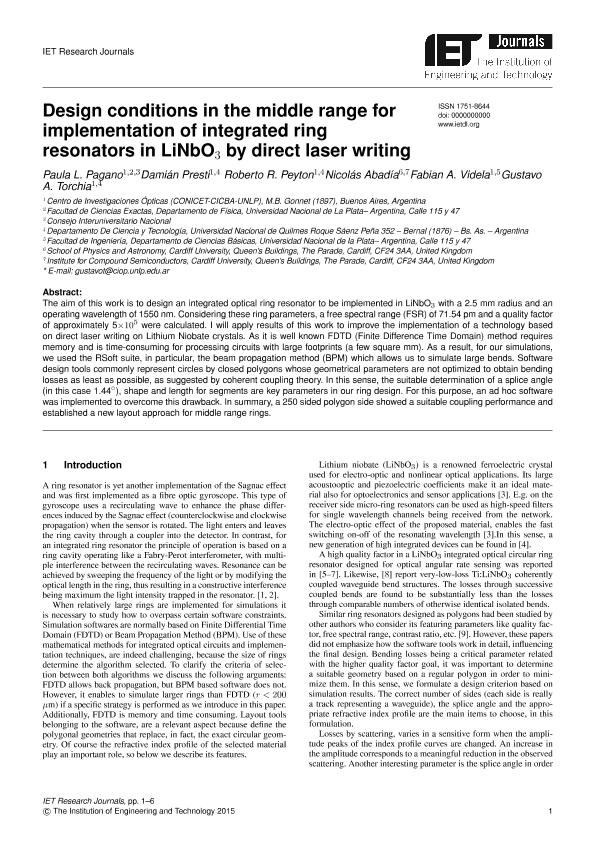Artículo
Design conditions in the middle range for implementation of integrated ring resonators in LiNbO3 by direct laser writing
Pagano, Paula Lujan ; Presti, Damián Ariel
; Presti, Damián Ariel ; Peyton, Roberto Ramon
; Peyton, Roberto Ramon ; Abadía, Nicolás; Videla, Fabian Alfredo; Torchia, Gustavo Adrian
; Abadía, Nicolás; Videla, Fabian Alfredo; Torchia, Gustavo Adrian
 ; Presti, Damián Ariel
; Presti, Damián Ariel ; Peyton, Roberto Ramon
; Peyton, Roberto Ramon ; Abadía, Nicolás; Videla, Fabian Alfredo; Torchia, Gustavo Adrian
; Abadía, Nicolás; Videla, Fabian Alfredo; Torchia, Gustavo Adrian
Fecha de publicación:
12/2019
Editorial:
Institution of Engineering and Technology
Revista:
Iet Optoelectronics
ISSN:
1751-8768
Idioma:
Inglés
Tipo de recurso:
Artículo publicado
Clasificación temática:
Resumen
The aim of this work is to design an integrated optical ring resonator to be implemented in LiNbO3 with a 2.5 mm radius and an operating wavelength of 1550 nm. Considering these ring parameters, a free spectral range (FSR) of 71.54 pm and a quality factor of approximately 5×105 were calculated. I will apply results of this work to improve the implementation of a technology based on direct laser writing on Lithium Niobate crystals. As it is well known FDTD (Finite Difference Time Domain) method requires memory and is time-consuming for processing circuits with large footprints (a few square mm). As a result, for our simulations, we used the RSoft suite, in particular, the beam propagation method (BPM) which allows us to simulate large bends. Software design tools commonly represent circles by closed polygons whose geometrical parameters are not optimized to obtain bending losses as least as possible, as suggested by coherent coupling theory. In this sense, the suitable determination of a splice angle (in this case 1.44◦ ), shape and length for segments are key parameters in our ring design. For this purpose, an ad hoc software was implemented to overcome this drawback. In summary, a 250 sided polygon side showed a suitable coupling performance and established a new layout approach for middle range rings.
Palabras clave:
MICROCAVITY RING RESONATORS
,
LITHIUM NIOBATE
,
COUPLING BOUNDARY
Archivos asociados
Licencia
Identificadores
Colecciones
Articulos(CIOP)
Articulos de CENTRO DE INVEST.OPTICAS (I)
Articulos de CENTRO DE INVEST.OPTICAS (I)
Citación
Pagano, Paula Lujan; Presti, Damián Ariel; Peyton, Roberto Ramon; Abadía, Nicolás; Videla, Fabian Alfredo; et al.; Design conditions in the middle range for implementation of integrated ring resonators in LiNbO3 by direct laser writing; Institution of Engineering and Technology; Iet Optoelectronics; 14; 3; 12-2019; 104-108
Compartir
Altmétricas



